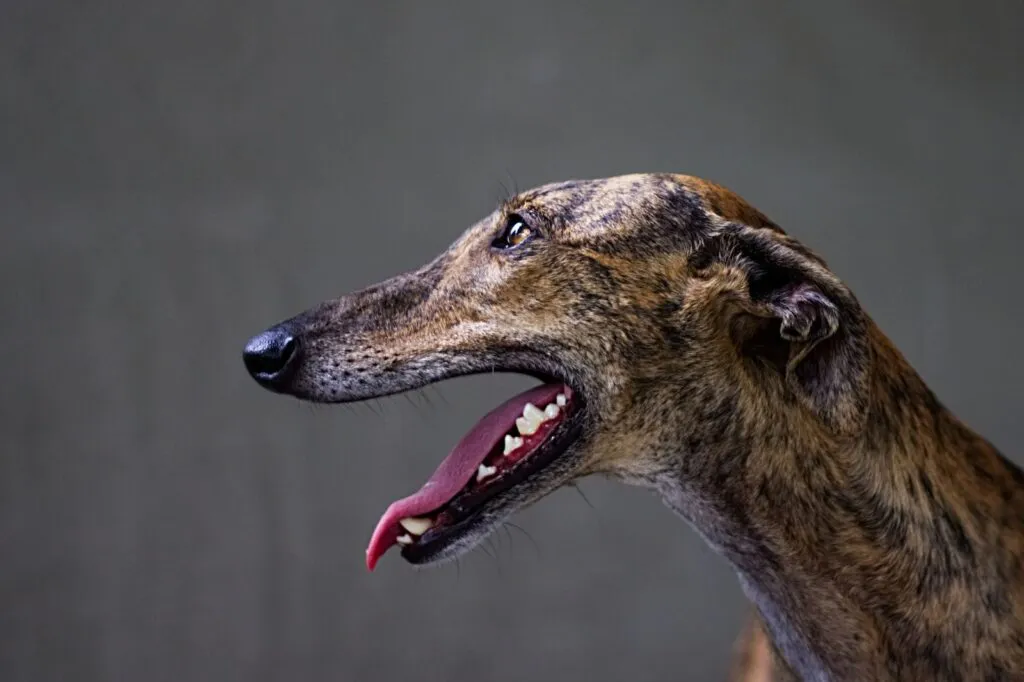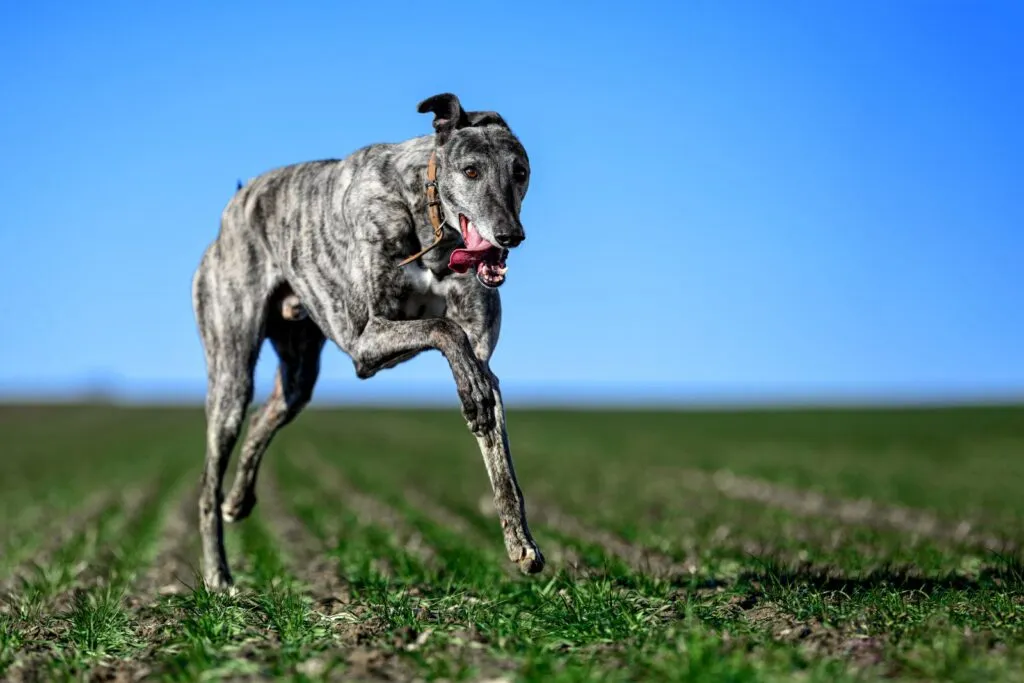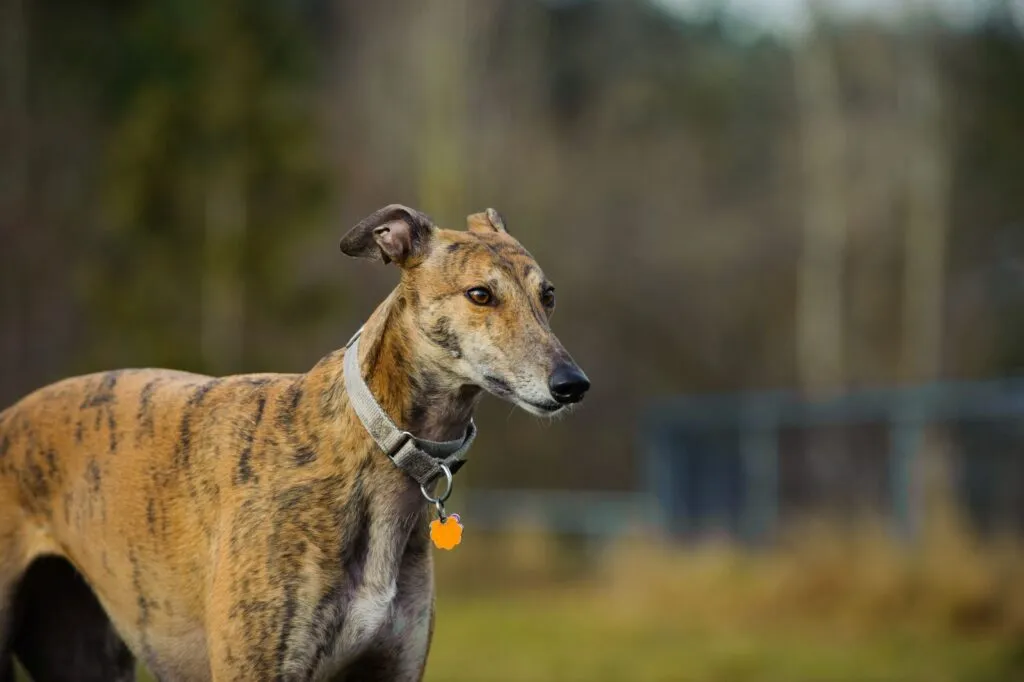Medium Size Poodle
The Greyhound is the prototype of a sighthound and one of the fastest land animals in the world. However, the large, slender Greyhound is much more than just a sprinter. Thanks to its calm and friendly nature, this British breed is an adaptable companion and an ideal family dog.

© Виктория Дубровская / stock.adobe.com
Greyhounds are not only one of the fastest land animals in the world but also one of the oldest purebred dogs
Greyhounds can reach top speeds of up to 85km/h, and although they sustain this speed only over short distances, racing sighthounds average an incredible 60 to 65km/h. Their entire body is designed for quick sprints. The long legs, deep chest, strong muscles, aerodynamic build, and elongated, narrow head radiate power and speed in every movement.
 © encierro / stock.adobe.com
© encierro / stock.adobe.com
Greyhounds belong to the large sighthound breeds, with males standing 71 to 76cm tall at the withers and females 68 to 71 cm. Despite their impressive stature, these dogs weigh only 23 to 33kg on average, although the breed standard does not specify a min. or max. weight. The fur is short and smooth, fine and dense.
However, Greyhounds are quite sensitive to biting cold or scorching heat due to their lack of underfat, and thin skin. In winter, during extended outdoor stays, it is better to dress the Greyhound in a warm coat.
The coat colour is quite varied. The standard allows the following colours and combinations:
Anyone who has seen a Greyhound racing with speed, power, and elegance will find it hard to believe this extraordinary sprinter can also be a quiet house dog, content to lounge for hours on the soft sofa near its family. In reality, the Greyhound is both an ambitious runner and a laid-back homebody.
The Greyhound shows endurance and stamina not only on the track but also when sleeping. Whether on a fluffy dog blanket, a cosy sofa, or even in its owner’s warm bed, some Greyhounds sleep for 16 hours or more a day. Despite their remarkable racing abilities, Greyhounds are surprisingly quiet household members that rarely bark and need little more than a soft surface and the company of their humans to be happy.
These social, people-oriented dogs do not like being alone. If you occasionally need to leave your Greyhound alone, it’s important to acclimatise it gently.
Thanks to their calm, gentle nature, most Greyhounds can, fortunately, be taken to the office, shopping, or restaurants without issues. Their adaptability and gentle demeanour make them easy and usually welcome companions.
Aggression is entirely foreign to this gentle and kind-natured Brit, who also gets on well with children. Even cleanliness enthusiasts will find nothing to criticise about this clean breed, which sheds little and rarely smells.
However, its leisurely, comfy demeanour should not overshadow the fact that the Greyhound, originally a hunting dog, still has a significant need for running. This may be less than one might expect from a high-performance sprinter, but owners should not underestimate it.
Unfortunately, free running is not always possible – after all, this breed is not only a runner but also a hunter, making it hard to do without a lead when walking in the park or on forest paths.
However, during coursing, on hobby racing tracks, or at sighthound clubs’ special facilities, Greyhounds can fully indulge their passion. Dogs that regularly get the opportunity for free running will be easy-going on a lead during daily walks and will happily snuggle on the sofa at home.
 © Ferenc / stock.adobe.com
© Ferenc / stock.adobe.com
Greyhounds are generally very healthy and robust dogs that develop few breed-specific illnesses. This applies not only to puppies from a reputable breeder but also to former racing Greyhounds that have passed stringent requirements for systematic performance breeding.
Typically, the dogs are screened for hip dysplasia, elbow dysplasia, hypothyroidism, von Willebrand disease, and potential eye defects. Another breed-specific condition is the “Greyhound Cramp,” which can result from excessive exertion combined with insufficient water and high external temperatures, leading to cramped muscles and even immobility. Therefore, if you notice a stiff gait or dark urine in your dog, go to the vet immediately.
Balanced nutrition is crucial for Greyhounds’ health. Dogs have specific nutrient needs that must be met through food. Since the nutritional requirements vary significantly depending on the dog’s age, size, build, metabolism, and activity level, the question of the right food cannot be answered with a one-size-fits-all approach.
Generally, meat should make up a significant portion of the dog’s nutrition, but which vegetables and fruits to add depends on the individual dog.
Those who prepare their Greyhound’s food themselves, such as when BARFing, should first familiarise themselves with the different foods, their nutrients, and the dog’s needs. Those who prefer to use a ready-made product from the pet store should carefully examine the ingredients.
If the ingredients start with grain, include animal or vegetable by-products, or contain sugar or artificial flavour enhancers, caution is advised.
Overall, the Greyhound is a very uncomplicated dog that, apart from its running needs, has few demands. This also applies to its care, which is quite straightforward due to its short, thin fur. Brushing once a week is sufficient. Dead hair can also be removed with a rubber glove.
The paws, however, may need a bit more attention, as they can be quite sensitive in some Greyhounds. Especially in winter, after walks on salted pavements, you should wash the paws with lukewarm water at home. Dog shampoo is generally not necessary.
The size of the Greyhound means it should have plenty of space in your home. An urban flat with no opportunity for free movement will not be suitable for this passionate runner and hunter in the long run.
A large property where the Greyhound can run freely and maybe even dash is ideal. However, the private area should be fenced, as once a hare or other small prey awakens the Greyhound’s hunting instinct, the large, fast sighthound is nearly impossible to stop. During walks in the forest, on fields, or in residential areas, your Greyhound should be kept on a lead – unless you can rely completely on its recall obedience.
 © everydoghasastory / stock.adobe.com
© everydoghasastory / stock.adobe.com
The Greyhound is not only one of the fastest land animals in the world but also one of the oldest purebred dogs. Its history can be traced back to pre-Christian times. The graceful and powerful dogs are depicted on tombstones, coins, vases, and cave drawings in the Middle East that are several thousand years old. Egyptian pharaohs had them mummified, and in Homer’s legendary Odyssey, Odysseus (800 BC) is recognised by a Greyhound after his battle against Troy.
The ancestors of this British breed arrived on the British Isles around the 4th century BC, in the company of Celtic immigrants. There, these highly regarded dogs were exclusively reserved for the nobility. King Canute of England imposed heavy penalties on any ordinary citizen caught with a Greyhound. King Howel of Wales even decreed the death penalty for killing a Greyhound in the 10th century. The English nobility invested a lot of money and time in breeding these fascinating hunting and racing dogs. Thus, the Greyhound is one of the few dog breeds that has been systematically bred for many centuries.
As the English nobility system changed significantly in the 16th century and wealthy non-nobles could now afford to keep and breed the valuable dogs, breeding expanded further. Originally bred for hunting live game, Greyhounds started being used for dog racing in the mid-16th century. While the dogs initially ran on open fields, they later raced on oval tracks, allowing spectators to follow the race.
What started as popular entertainment soon developed into a billion-pound racing industry with enormous bets. Greyhound racing still takes place in Australia, the USA, and especially in Ireland. Greyhounds are primarily bred for speed, generating substantial winnings in races. Older dogs that can no longer perform are quickly disposed of. The killing of Greyhounds deemed useless for the betting industry is even legal in Ireland.
To combat this practice, several countries have founded organisations dedicated to rescuing racing Greyhounds and finding them homes with families. In some countries, such as Germany, Greyhound racing is now only a hobby for dogs, owners, & sighthound enthusiasts, and betting is prohibited. Thanks to these efforts, many former racing dogs have found new homes. In the USA and other countries (excluding Ireland), there are now more racing Greyhounds in families than on the track.
Dog breeds you might also like: If you like the Greyhound, you might also be interested in these breeds:
If you’re interested in a Greyhound and want to give a retired racing dog a second chance, consider contacting a Greyhound rescue organisation. Even though racing dogs trained for peak performance may need to catch up on socialisation, integrating an adult Greyhound into a family usually goes well.
Those experienced in dog training, who approach these sensitive sighthounds with patience and calm, and provide them with a firm place in the family will soon have a loyal and affectionate partner.
If you prefer a young Greyhound, unburdened by past experiences, and want to train it from a young age, it’s essential to go to a reputable breeder. Breed clubs usually have a list of registered breeders expecting litters.
Before deciding on a puppy, visit the breeder at least once, preferably several times. If the breeder gladly shows you their home and dogs and is genuinely interested in you and your reasons for wanting a Greyhound, that’s a good sign. A reputable breeder, who breeds out of love for the breed, cares deeply about the welfare of their Greyhound puppies and ensures they go to suitable and loving homes.
If you haven’t considered whether you can regularly let your sighthound run freely, the breeder might initially advise against the purchase. If the breeder trusts you with one of their puppies, ensure you get all the necessary documents. These include health examination records and vaccinations, as well as the official pedigree. The price for a healthy Greyhound puppy from a breeder starts at around £1,000.
Fans of the Bearded Collie agree that those who aren't familiar with this dog breed simply have to get acquainted with it. And those who have experienced how a Bearded Collie bolts across meadows with its flowing fur, how it rolls around full of energy and joy and how it attentively and observantly takes into account its owners wishes become simply addicted to this original dog breed and its unique charm.
The Goldendoodle isn't a breed, but a pairing between Golden Retrievers and Medium or Standard Poodles. Marketed as a low-maintenance dog for allergy sufferers, this hybrid is enjoying increasing popularity amongst dog lovers, similar to the Labradoodle.